| |
Hilltop and the Sign
Working Draft
Tom Butt, Mayor, City of Richmond
March 8, 2015
Introduction
The debate about whether or not Richmond should amend its sign ordinance to allow large LED billboard signs with constantly changing messages is largely driven by advocates for such a sign at Hilltop.
Personally, I believe that all billboards are blight, whether they just sit there or whether they flash a new message in bright LED every seven or eight seconds.
The purpose of this paper is to summarize the debate over an LED billboard at Hilltop and the larger debate over an amendment to the Richmond sign ordinance that would allow such a sign not only at Hilltop but also at other locations in Richmond along I-80 or even I-580.
Also see Richmond Residents Overwhelmingly Reject LED Billboards.
To understand the context of the sign debate, you have to first understand the history and context of Hilltop Mall and the Hilltop retail area.
Hilltop Mall – Past and Present and Future
Hilltop Mall[1] opened in September 1976, built on land previously occupied by the Chevron Oil Corporation tank farm. Both the parcel occupied by the mall proper and the surrounding parcels outside the ring road (Hilltop Mall Road) were originally marketed by the Chevron subsidiary, Chevron Land and Development Company.
The mall, itself, was developed by A. Alfred Taubman, who also developed several other shopping malls in the East and South Bay Area, including Eastridge Center in San Jose, Stoneridge Shopping Center in Pleasanton and Sunvalley Mall in Concord. Originally, Hilltop Mall was anchored by a bright red-tiled Capwell's, JCPenney and Macy's. Both Macys and JCPenney originally had stores in downtown Richmond, but while Macys had closed its downtown store a couple of years earlier, JCPenney kept its downtown store open for another year after Hilltop opened. Capwell's changed its name to Emporium-Capwell in 1979, before becoming simply Emporium in 1990. Sears was added in 1990 and was the last expansion of Hilltop Mall.
Once opened, the mall attracted the major anchors of Richmond's downtown, which became deserted, with several major national chain stores closing, although many acknowledge that the trend predated Hilltop due to economic and safety issues.

Hilltop Mall center court area with the gold anodized sculpture "solar cantata" (1971)
The mall remained largely unchanged until 1996 when the Emporium store closed following its merger with Federated, who owned Macy's. The store remained vacant until October 1998, when Macy's refurbished and relocated their existing store into the former Emporium space. However, Federated chose not to have two Macys at Hilltop (unlike Sun Valley, Stoneridge, and others) and closed the original store. That building would remain vacant until WalMart took it over in the spring of 2007.
The Taubman shopping center interests, which had become a publicly traded real estate investment trust in 1992, were reorganized in 1998, and the GM Pension Trust assumed full-ownership of Hilltop Mall at this time, retaining Taubman Centers as manager. In its turn, in 2004 the GM Pension Trust sold a half-interest in a portfolio of shopping centers, including Hilltop to The Mills Corporation, which also assumed management of the center. After several years of delay, Wal-Mart opened on April 11, 2007 on the site Macy's vacated in 1998.
In July 2007, Simon Property Group purchased the entire The Mills Corporation portfolio including other Bay Area properties: Stoneridge Shopping Center in Pleasanton, California and Great Mall in Milpitas, California. On December 23, 2011 shots were fired and the mall was closed due to a shopping frenzy over the retro Air Jordans on sale that day. The mall later reopened but sales of the shoe were banned for the day. Similar events occurred at the nearby Westfield Solano and the Bayfair Center malls in Fairfield and San Leandro respectively.
In August 2012, Greg Maloney, president of Jones Lang LaSalle Retail (JLL) was appointed receiver by the Contra Costa Superior Court to assume management of the property due to Simon's loan default. JLL retained Michael Piazzola as its managing receiver. The property was foreclosed on in June 2013 by US Bank as a trustee representing a consortium of lenders that underwrote the original Mills acquisition in 2007. Jones Lang LaSalle was retained as the manager post-foreclosure and has attempted to stabilize the asset in anticipation of its eventual sale by the trustee.
What we know as Hilltop Mall consists includes not only the property currently under receivership but also three independently-owned anchor stores: JC Penny, Macys and Sears. The fourth anchor, Walmart, is a tenant of the foreclosed property.
Technically not a part of Hilltop Mall are dozens of businesses on separately owned parcels accessed directly and indirectly from the ring road, Hilltop Mall Road. These include the Century Hilltop 16 movie complex, the Auto Mall cluster of auto dealerships, Courtyard by Marriott, Extended Stay America, The Tides apartments, and many others.
Once prominent on the ring road was the corporate headquarters of Mechanics Bank, now relocated to Walnut Creek. The building will soon be offered for sale. Just within the last week, one of Hilltop’s free standing restaurants, La Revolucion, unexpectedly closed its doors.
When Simon Property Group owned Hilltop Mall, they also owned the highly desirable and more successful Stoneridge Mall in Pleasanton, and they used the leverage of the Stoneridge Mall to force national brands to open a store at Hilltop in order to gain entry into Stoneridge. Typically, these were five-year leases, and when they ran their term, the nationals fled Hilltop like rats leaving a sinking ship, leaving second and third tier regional and local brands as tenants.
The waning success of Hilltop is primarily due to its outdated 1970s configuration and business model, a fate share by decades-old malls nationwide. Currently Hilltop has 400,000 square feet of space with 100,000 square feet vacant. Also contributing to its lackluster performance is a demographic that does not have significant disposable income.
Both sales overall and Hilltop’s share of Richmond’s sales tax revenue are continuing to decline.
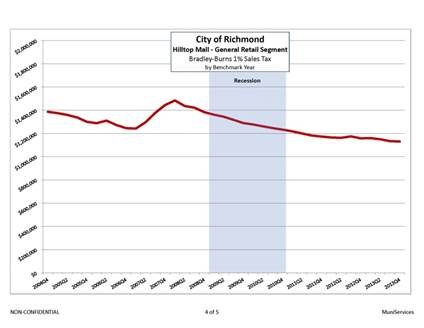
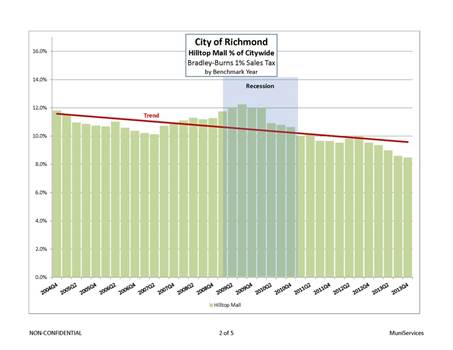
Modern shoppers prefer “main street” or a shopping experience that mimics “main street.” The footprints of the typical store spaces are much deeper than is considered efficient in modern retailing, where the ideal footprint is a compact 30 feet x 50 feet. The anchor stores are twice as large as they should be.
Examples of shopping complexes that have adapted to the new preferences of customers are Broadway Plaza in Walnut Creek, Stanford Shopping Center, Bay Street in Emeryville, Santana Row in San Jose and Valley Fair in San Jose.
Michael Piazzola, an expert in shopping centers, acknowledges that the future for Hilltop Mall in its current configuration is dim. In fact, the property is actually worth more cleared of existing building than it is intact.
A future buyer is also faced with the challenge of finding a configuration acceptable to the three independent store owners, so a solution will have to involve cooperation and collaboration, both potential opportunities as well as potential curses.
The future Hilltop will likely involve the addition of significant housing, the downsizing of anchor stores, and reconfiguration as a mixed-use “main street.” What is there now will have to be destroyed to be saved.
The Hilltop Sign
What does all this have to do with the proposed LED sign at Hilltop? Advocates for the sign typically include sign companies that see it as a profitable venture and some residents who see it as a way of saving Hilltop Mall, or at least staving off its demise, and benefiting the businesses surrounding the mall.
The anchor stores at Hilltop do not see the proposed LED sign as a boon for them. Jennifer Sweeney, Store Manager for Macy’s, believes that rushing an LED sign could backfire. She thinks we should wait until the Mall is sold and the new owner establishes a new identity that would presumably include an advertising program. Jump-starting the sign could result in a long term commitment that is not in the Mall’s best interest.
The existing Hilltop sign is a vertical slab consisting of steel panels erected in the 1970s when Hilltop Mall was constructed. Over the years, the content of the sign has continued to evolve, but it is generally regarded as unattractive and by some, ineffective..
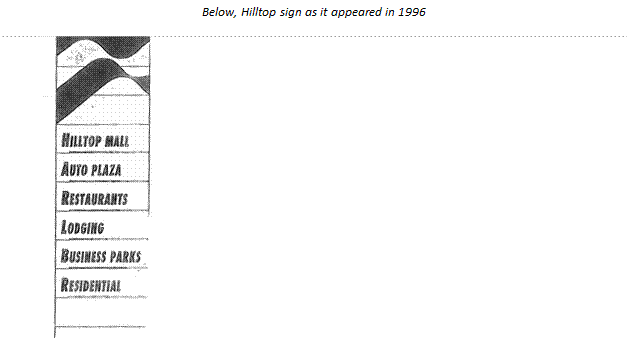
On December 15, 1995, Chevron Land and Development Company, the original developer of the Mall and surrounding properties conveyed to the City of Richmond the sign itself as well as an access easement to maintain it. On January 22, 1996, the City Council adopted Resolution 13-16 that accepted both the easement and ownership of the sign.
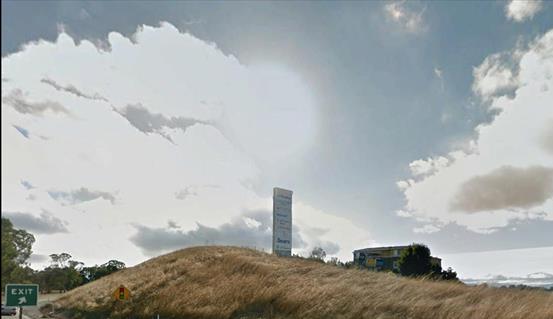 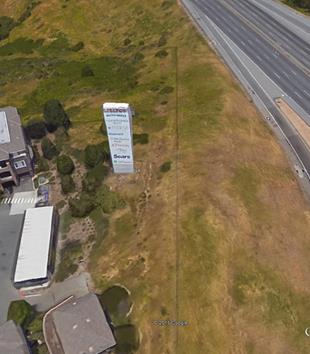 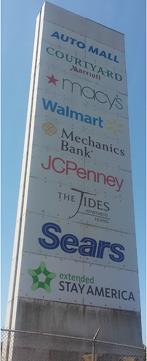
Although the City Council vote was unanimous, including me, I cannot recall why the City agreed to take ownership or why I supported it.
In any event, the City of Richmond owns the sign, not the businesses that advertise on it.
Chevron Land and Development Company ultimately divested all of its property at Hilltop, and the underlying parcel where the sign is located is currently owned by Richmond Tides Owners, LLC. The Tides, an apartment complex, is one of the advertisers on the current sign, along with Auto Mall, Courtyard by Marriott, Walmart, Mechanics Bank, JC Penney, Sears and Extended Stay America.
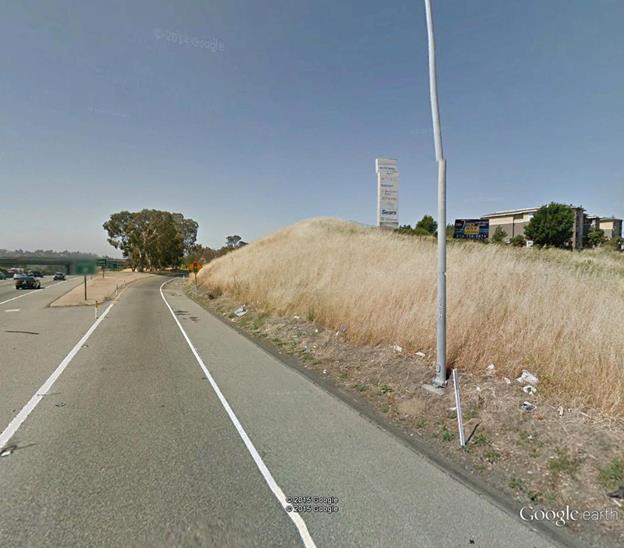

What is unclear is who actually pays to maintain the sign and who decides what businesses will be advertised on it and how they will be presented.
It is puzzling that the businesses that advertise on the sign have failed to take “ownership.” Instead, the primary advocates appears to be
Hilltop District Owners and Stakeholders Association
- Country Club Vista HOA – 650 homes
- Fairways HOA – 88 homes
- Lakeview HOA – 44 homes
- Hilltop Dodge Ram
- MEI Capital - Vista Del Mar Shopping Center
- Hilltop Mall
- The UPS Store, Richmond
- Hilltop Chrysler Jeep Dodge Ram
- Hilltop Chrysler
- Hilltop Ford
- Tiparos Thai Kitchen (formerly Sala Thai)
- La Revolucion
- AM/PM Gas Station
- Extended Stay America
- Extended Stay America
The strategy for realizing a new sign has been to incentivize an outdoor advertising company to build and maintain it at no cost to Hilltop businesses. The quid pro quo would be for the outdoor advertising company to operate a large LED billboard as part of the sign. Two examples of possible signs are shown below, with the one on the right representing the version preferable to the advertising industry.
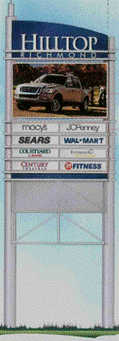 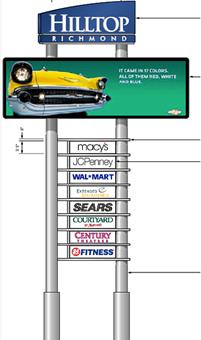
On March 3, 2015, the day the City Council finally took up the sign ordinance amendment that would allow LED billboards, Cesar Zepeda, President, Hilltop District Neighborhood Association wrote in an email entitled, “Why Hilltop Needs a New Sign.”
This Ordinance was brought forward because the Hilltop District needs a new sign to replace the old, oxidized, broken, light-polluting, and outdated pylon sign currently in place. The sign is the only way that the 300+ thousand daily motorists on Highway I-80 know that Hilltop is a shopping/business district. Our district contributes a large amount of revenue to the City; we have car dealerships, restaurants, hotels, a movie theater, a mall, and in excess of 100 additional businesses elsewhere in the District.
Brief history: In approximately 2008, the Hilltop District was set to get a new sign to replace their outdated pylon sign. The City of Richmond planned to pay for another pylon sign out of redevelopment funds. When the time came to move forward with the sign, the line-item was removed from the budget, as the redevelopment funds were no longer available to pay for it. The City told the District to find other ways to fund the sign if they wanted a sign.
The District found a sign company that would come in and pay for a modern sign! The cost for the sign would be about $1.4 million dollars. The sign company applied for a permit to put up the sign, received the permit, and later was told it was issued in error because the current ordinance does not allow for digital signs.
The District has been working with the City and communities to amend the sign ordinance, to make sure it provides the best benefit to everyone in our City. The Hilltop District only wants one sign; however, the ordinance needs to be written in such a way that it covers all of the City future plans.
Why the District wants the sign ordinance: Allowing for the Sign Ordinance to move forward would bring great benefits to the City and the communities all around the City. We have gathered more than 100 signatures from residents and businesses from all over the City. Several Neighborhood Councils have either written letters in favor or the ordinance or have remained neutral on the item; not one letter from a Neighborhood Council has been against the ordinance (to our current knowledge).
The single greatest benefit to Richmond communities is that it could be the only way to remove currently erected, static billboards; the billboards we see on highway 580, near MacDonald Ave, etc. Those billboards are there to stay unless this ordinance is passed. The Memorandum Of Understanding (MOU) given to the sign company that applies for an application would say that they would need to remove 10 static billboards per face on a digital sign, Each digital sign has two faces, therefore they would be required to remove 20 static billboards! If they don’t own any signs that could be removed, they could provide something in exchange, such as enhancements to a park, art, community programs, etc.
Other benefits of the ordinance: It would bring approximately $200,000 in revenue to the City annually, per sign. This is in addition to the tax revenue coming in from the sign or because of the sign. Our City is facing a $7.4 million budget deficit; this money can greatly help offset that.
Who maintains the sign now? The City does; tax payers pay for it. Who would pay the maintenance of the new sign? The sign company; cost to the taxpayers: $0.
We would have less light-pollution. Save on electricity. Bring more tax revenue to the City. And most importantly, it would drive business into the district. If we can get 1% of the drivers on I-80 to stop and shop in the district every day, it would help all the businesses in our district. There is a great amount of time to look at a sign such as the one being proposed. Think of the morning and evening crawling traffic on I-80. It would also help the homeowners with their property values to have a thriving business district.
A few things to note:
- The Mall was in foreclosure and now it is in receivership.
- It’s supposed to be sold sometime in 2015/2016.
- The previous owner walked out on it about 3 years ago.
- Several businesses have moved to Pinole, that were once in Hilltop.
- The sign is not owned by the mall, it is owned by the City/Community.
The few people that come to our district now, are because they already know of the mall. Once the mall is under construction, what will happen to all the small businesses around the area that count on the traffic that comes to/from the mall?
The sign is not meant to save the mall. That is a big misconception going around. The sign is meant to help all the businesses in and around the mall. The sign will provide an opportunity for the businesses to save themselves.
Our District has been told, “Let’s wait and see what happens” when we asked for help before. The first thing that happened was that the largest retail owner in the world left our mall in foreclosure, and in turn, left all the small businesses around the area to suffer because they stopped putting time and energy into the mall. It was our District that let the City know that the mall owner left, so they could focus needed attention in the District.
The ordinance will be City-wide. The sign will be for our District. Our District needs help. If we do the “let’s wait and see what happens” approach again, who knows what will happen.
It has become clear, however, that many of the often-repeated claims about the proposed ordinance amendment and the proposed Hilltop sign are not accurate:
- Allowing an LED billboard would not guarantee removal of existing billboards. Only if one of the two companies that owns existing Richmond billboards (CBS Outdoor and Clear Channel) ends up taking out a permit will existing billboards be removed. It is interesting that a giant electronic billboard is considered desirable while traditional billboards are considered “blight.”
- There is no guarantee that an LED billboard at Hilltop would even replace the existing Hilltop sign. An ordinance cannot compel this. The locations of the existing sign may not be the most attractive location for an LED billboard. Such a sign could end up wherever a sign company and a property owner could make a deal.
- There is no guarantee that the City of Richmond would share $200,000 in annual revenue, or any other amount, from an LED sign. This could happen only if the sign is on City owned or controlled property.
- The City of Richmond has no contractual obligation to maintain the existing Hilltop sign.
- There is no guarantee that an LED billboard would “drive business into the district.” In order to be profitable for a sign company, an LED billboard would have to feature whatever advertisers are willing to pay the price. Looking at other LED billboards around the Bay Area, we see largely national or regional advertising, 8 seconds at a time. You can’t actually see most of the Hilltop complex from I-80, and there is no compelling evidence that an LED sign, or any sign for that matter, is going to act as a powerful diversion for drivers on !-80 to leave the freeway to shop.
- A petition was cited that included 100 names in support of the sign, and it was stated that not one neighborhood council opposed the ordinance. One hundred petition signers among 30,000 registered voters does not indicate significant support. Staff has pointed out that an ordinance amendment allowing LED billboards cannot legally limit them to Hilltop, and here is little support for such signs in other areas along I-80. In fact, the Richmond Annex neighborhood council has gone on record as opposing such signs.
- While the current sign is reasonably visible from the westbound (actually southbound) lanes of I-80 and the Richmond Parkway off ramp, it has minimal visibility from the eastbound (actually northbound) lanes of I-80. It is not visible at all until a driver passes under the Hilltop Drive overpass and then only obliquely for a few seconds.
 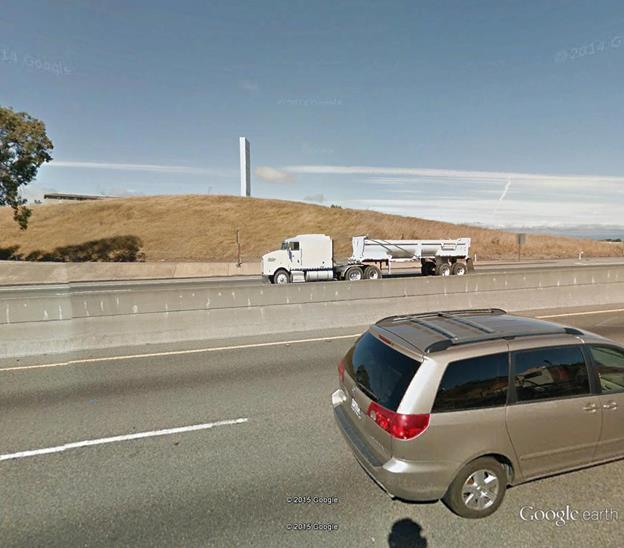
Where Do We Go From Here?
We know that the future of the Hilltop Mall is up in the air. It is not a sustainable business model and will soon be sold. There is a good chance that it will be razed and may reappear as something entirely different than it is now. It makes no sense for the City to enter into or encourage a long-term investment in a sign program that may be obsolete or misdirected in as soon as in a year or two.
It is not clear that a giant LED billboard that advertises other than Hilltop business offerings will have any significant impact on Hilltop businesses outside the mall proper. The attraction of the LED billboard is largely an incentive for an outdoor sign company to pride a new but conventional static display of signs advertising Hilltop businesses and the Hilltop District.
Since most of the debate seems to center around replacing the existing aging and deteriorating sign, that is what we should focus on. What will a new conventional sign cost, and who will pay for it? Is it in the best location? If not, the City could conceivably obtain a better site using eminent domain if there is not a willing seller.
It appears that formations of a Hilltop Business Improvement District (BID) would be a good start to generate investment that the owners of Hilltop businesses agree are their highest priorities. Downtown Richmond Business Improvement District is a local example, and there are successful examples nationwide.
The Hilltop District Owners and Stakeholders Association has been successful in forging a collaboration among smaller homeowners associations and a number of Hilltop businesses, but it has no funding source for ambitious projects. Although it has emerged as an informal advisory and watchdog body for the Hilltop Landscape Maintenance District, it has no formal authority since the Hilltop Landscape maintenance District is governed by the City Council. While championing a LED Billboard, the The Hilltop District Owners and Stakeholders Association purports to have opposed the use of landscaping funds for the new wayfinding signs at Hilltop.
A new Hilltop Business Improvement District could both raise and control substantial funds directed towards business interests, including funding and maintaining a new sign. Mr. Zepeda wrote in a recent email:
The HLMD took out a loan to put up the way finding signs, however I don't think we should have been made to do so; we are a Landscape and Maintenance District, not a Business Improvement and Development District. The sign is a general benefit and should have been paid for by the City. Payments are still being made on the sign. Loan Payment Principal Portion $67,850, plus interest of $7,428 for the year; total for the signs is about $600K. With this said, the HLMD was not created for signs. Right now we are working to make sure our Assessment is used properly for Landscape and Maintenance.
The way finding signs, we are having to pay for, were not designed properly; at night you can't see the signs, they have no light. They were intended to reflect as you are driving at night, but unless you are driving straight into the sign, you can't read it. We are working to fix this oversight when the City approved the signs and their design. One would think that at $600K, you would be able to see the sign regardless of the time of day/night.
Instead of trying to force an ordinance amendment that would allow multiple LED billboards along I-80 in Richmond, we should be more circumspect and work on solutions that actually will have the most benefit for those businesses. Other types of advertising, including social media, signature events, multi-media campaigns, and emerging technologies might be better and more effective investments.
The Mayor’s Office has made it a priority to pursue public policies that will benefit business at Hilltop and reverse the flagging cash flow from the mall. We will continue meeting to find the right solution, but I don’t think it will include a giant LED billboard.
APPENDIX A – Commentary by Marilyn Langlois, Planning Commissioner
Planning Commission to Consider
LED Advertising Signs in Richmond?
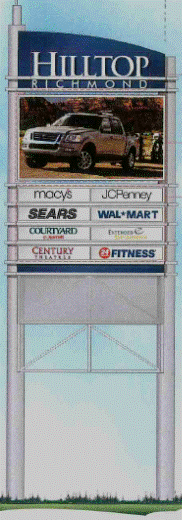 |
Proposed LED Sign, 132 ft tall |
By Marilyn Langlois, Richmond Planning Commissioner
Richmond's Planning Department staff are currently working on a proposed modification in the sign ordinance to allow for LED advertising signs with changing images under certain circumstances. The proposal will first be presented to the Planning Commission to make a recommendation to the City Council, possibly at the May 1 Planning Commission meeting. We'll keep you informed if this date changes.
After participating on an ad hoc committee of Planning Commissioners and Design Review Board members, I continue to have serious concerns about the advisability of allowing LED signs in Richmond. It would set us down a slippery slope of ever-increasing and constantly changing garish visual images advertising mostly products for big corporations.
These types of LED signs are extremely distracting to drivers. They are designed to try and keep drivers' eyes looking at them and their contents for a longer period of time than stationary signs, and that's what the advertisers want too. I want drivers focusing their attention on the road.
The proposed ordinance changes would allow for large, billboard sized LED signs at major shopping areas such as Hilltop and Macdonald/I-80, after going through the DRB and getting a conditional use permit from the Planning Commission. Depending on design requirements these could be either horizontal (what the advertising companies prefer) or vertical (as recommended by DRB member Mike Woldemar). Another provision would allow for sign companies like Clear Channel and CBE Outdoors to get a permit for LED billboards at major shopping areas if they agree to permanently remove some of their other stationary billboards in other parts of Richmond.
There is currently a somewhat smaller LED sign with changing images at Pacific East Mall, which was installed during a time when such signs were allowed only after following a specific approval process (including noticing the neighbors and vetting through DRB), In that case, the required process was not followed, however, and the legality of that sign has been questioned. Since then, the ordinance was modified to prohibit LED signs.
The big sign companies are garnering support from businesses at Hilltop with the promise of erecting a big sign to advertise the Mall free of charge, but at what price? I doubt people will be any more likely to go to Hilltop Mall if LED signs are introduced there. A big billboard with changing images will draw attention to the various products advertised on those LED images, and not to the stationary listing of businesses affixed to part of the sign. Besides, there are other reasons why Hilltop businesses are struggling. Could it be that the presence of Walmart has caused many of them to fold, as has happened in other cities? Why doesn't Walmart (one of the world's wealthiest corporations) pay to erect a visible, attractive stationary sign that lists all of its Hilltop neighbors?
If the proposed ordinance is adopted, what if Hilltop businesses still don't do any better after the LED sign is in place? We'd be stuck with the constantly changing advertising slide show there and most elsewhere in the city.
Clearing the air on digital billboards
by Marilyn Langlois, Richmond Planning Commissioner
As a Planning Commissioner and member of a special ad hoc committee of Planning Commissioners and Design Review Board members, I have been studying this issue for over a year. In addition to multiple discussions at Planning Commission meetings, I’ve had numerous in-depth conversations with Richmond residents, business owners and City staff, hearing arguments both in favor and opposed to allowing digital billboards in Richmond. Those in favor generally believe they will help revitalize the Hilltop Mall, and those opposed generally find them unsafe and unsightly.
I appreciate that there are differing points of view within the RPA on this issue, and would like to correct some misinformation contained in the opinion piece submitted by Cesar Zepeda on the RPA website, with regard to the following two claims of potential benefits to the City.
Big loophole in requirement for removal of existing stationary billboards:
The ordinance would require a sign company that currently has stationary billboards in Richmond to remove 10 times the square footage of those stationary signs for every digital billboard erected. There are currently two sign companies with stationary billboards, Clear Channel and CBS Outdoor. If any other sign company applies for a permit to erect a digital billboard, no existing stationary billboards will be removed. Alternative amenities would need to be negotiated with the City Council, but we’d still have all those billboards. Mr. Zepeda refers to an offer by an unnamed sign company to pay the cost of erecting a digital billboard in the Hilltop area. There’s no evidence that this company is either Clear Channel or CBS Outdoor, and even if one of them wanted to build a digital billboard in Richmond, they could use another company as a front to apply for the permit.
No anticipated additional revenue to the City:
At both the Planning Commission and in the staff report for the City Council, Planning staff made it clear that “revenue sharing opportunities for the City are limited”. If a digital billboard is located on private property, such as Hilltop Mall, there is no way for the City to receive any revenue beyond the nominal initial permit fees. Mr. Zepeda claims that the City would receive about $200,000 in revenue annually for each digital sign, but does not provide evidence for this. The staff report states: “Generally, cities may only collect rent and/or a share of the advertising revenue if the sign is located on city-owned property.” Currently there are no City owned properties in C-3 districts that would be suitable for digital billboards.
With regard to claims of widespread support for digital billboards among Richmond residents, some of this support may be based on having incorrect information on the two issues discussed above.
The Planning Commission received much input in favor of digital billboards from several residents and businesses, including one of the Homeowners Associations in the Hilltop area. We did not receive a formal position one way or the other from the Fairmeade-Hilltop Neighborhood Council. The Richmond Annex Neighborhood Council and the Marina Bay Neighborhood Council both opposed allowing any digital billboards along the I-580 scenic corridor. In addition, many residents, including some from the Richmond Annex Neighborhood Council expressed concerns about allowing digital billboards even in C-3 areas, due to potential hazards and blight. Mary Selva of Richmond Annex did extensive research, contacting planning departments in many other cities in the Bay Area and found that very few of them currently allow digital billboards.
I met extensively with representatives of one of the Hilltop Mall businesses, Courtyard/Marriott, who told me that the proposed sign would include both a digital billboard for offsite advertising of various products as well as a stationary component with the names of several Mall businesses. They believe that having this sign would bring more customers to their business. This would be desirable if it were actually the case, but the reality with these kinds of signs is that in the second or two when drivers pass them on the freeway, their eyes will be drawn first to the digital portion, with various car, beer, soda, etc. ads. I question whether drivers will notice the stationary names of businesses any better than they do now with the existing Hilltop Mall sign.
At the Planning Commission, I asked staff to include findings with evidence supporting the notion that placement of digital billboards would bring measurable benefits to local businesses, and they were unable to provide any.
Whether this ordinance passes or not, it’s clear that much more will need to be done to truly revitalize Hilltop Mall, as Mayor Butt discussed extensively in his State of the City address in January.
Finally, beyond lack of evidence for any real benefit to the Richmond residents or businesses, the issues that swayed me the most at the Planning Commission to vote against allowing digital billboards are safety and aesthetics.
The proposed signs would be huge: 14 x 48 feet, and two-sided each, with illuminated advertisements changing every few seconds. Stationary billboards, which are no longer allowed to be built in Richmond, are already a blight on our community, and this addition would further damage the look of our city.
When it comes to safety, studies can be found making a wide variety of claims from no impact on accidents to significant increase of risk for accidents. The sign company representatives, who have an obvious profit motive, push the former, but residents provided the Planning Commission with the latter as well. We need to follow the precautionary principle, and opt for the safest way to go, when in doubt. Next time you drive by a digital billboard on I-80 or I-880, notice how your eyes are drawn to that illuminated, changing image, which is exactly what the advertisers want. Then think what the consequences could be of not having your eyes on the road, even for a split second.
Allowing digital billboards in Richmond would set us on a course that could not be reversed if they end up not bringing the benefits many hope for. It’s a slippery slope that we should not go down.
Appendix 2 – Commentary by Jerry Wachtel, CPE, President, The Veridian Group, Inc.
Ladies and Gentlemen:
I have been sent a copy of an email from Mr. Amit Patel, dated March 25, 2014, and titled: “Hilltop Pylon Sign,” and asked to reply.
By way of background, I have studied traffic safety and driver distraction issues for more than 30 years. I was the senior author on the first U.S. study of the safety and environmental impacts of digital billboards (published by the Federal Highway Administration [FHWA] in 1980, and I was a consultant in the early phases of the recently issued FHWA report to which Mr. Patel refers.
In response to some of the statements made by Mr. Patel concerning the FHWA study, let me raise certain points:
1. The study was not peer reviewed as Mr. Patel claims. An earlier (unpublished) draft of the study was peer reviewed. The criticism by the peer reviewers was so harsh that the study was withheld for nearly two years before a revised version was published. There is no indication that the latest version received peer review, or that the original peer reviewers were given an opportunity to determine whether their criticisms had been satisfactorily addressed.
2. The prior studies on this topic prepared by FHWA and mentioned by Mr. Patel were also not subject to peer review. (I served as a consultant on some of these earlier studies as well).
3. Mr. Patel claims that the FHWA study “is currently the most complete dataset available for review.” Although I do not know what he means by this, I should point out that there is considerable recent published research, worldwide, that demonstrates the adverse effects of roadside advertising signs on driver behavior and performance. (Most of this research has been peer reviewed. I have cited some recent examples at the end of this email. A study conducted by me on behalf of AASHTO (American Association of State Highway and Transportation Officials), which discusses all of the relevant research prior to 2009 is included in this list. Note that, after a recent study of such signs in Sweden, the government removed all digital billboards from their roads.
4. One of the documents cited by Mr. Patel refers to a memorandum in his discussion of a sign that “passed through (the) Design Review Board in 2008.” A quick review of this memo indicates that its author identified the proposed replacement sign at Hilltop as “Categorically Exempt” from CEQA review under CEQA Guidelines §15311(a): On-premise signs. My reading of the description of the proposed sign in this same memo suggests that this exemption was applied erroneously. Specifically, the memo states: “the message center will be used to display local and national ads as well as to promote citywide events and attractions.” This language suggests that the proposed sign would, in fact, be considered an off-premise sign, or billboard, and thus subject to far more stringent regulation and control than if it was strictly an on-premise sign. (I note here that the existing sign at the Pacific Mall (to which Mr. Patel refers) is ostensibly an on-premise sign, but it is currently operating as a billboard by advertising off-premise businesses and services).
5. Mr. Patel claims that the proposed sign will feature “backlit panels.” This is not correct. LED signs, which is what is proposed, use thousands of individual “light emitting diodes” (LEDs) to create the image and manage its colors. Each LED is considered “self-illuminating,” and depending upon the number of LEDs and the density with which they are assembled into the sign substrate, such a sign can have far greater luminous intensity (i.e. brightness) than can any other form of signage. Lighting experts are at odds with industry representatives about: (a) how this brightness should be measured; (b) how much brightness is necessary at night; (c) how such signs should be dimmed, and to what degree; and (d) what to do about sign display brightness when any component of the lighting or dimming system fails. Current LED sign owners/operators typically set their signs, at night, to luminance levels 2-5 times greater than lighting and traffic safety experts recommend. Further, the proposed sign, given its proposed height and elevation, will likely create high levels of nighttime luminance and glare directly into the windows of the nearby Tides apartments and Extended Stay America hotel. This does not seem to have been addressed by Mr. Patel or other reviewers of the proposed sign.
6. Mr. Patel cites a sign industry study to show the advantages of such signage. Of course, studies conducted by those not tied to the sign industry demonstrate that drivers and citizens are strongly opposed to digital roadside advertising signs, and find them generally useless for obtaining information relevant to their needs. A summary of some of this research is shown in the Reference list below.
I am not opposed to digital billboards. I have served as a consultant to each of the “big 3” owners of such signs and the Outdoor Advertising Association of America (OAAA), as well as to city, county, and state government agencies throughout the country, in an effort to help craft regulations and guidelines that support traffic safety while not infringing on the right of sign owners and operators to conduct their business. I believe that there are straightforward ways to design, locate, and operate roadside digital advertising signs that can serve their clients while mitigating traffic safety concerns. Sadly, my experience has been that manufacturers and operators of such signs too often insist on maximizing profit at the expense of traffic safety and environmental concerns.
I am available to assist the City as it considers the issues surrounding such signs, the effects of which will be felt for many years to come.
Sincerely,
Jerry Wachtel, CPE
President, The Veridian Group, Inc.
Berkeley, CA
510-848-0250
jerry@veridiangroup.com
REFERENCES:
Backer-Grøndahl, A., & Sagberg, F. (2009). “Relative crash involvement risk associated with different sources of driver distraction.” Proceedings of the First international Conference on Driver Distraction and Inattention. Gothenburg, Sweden: Chalmers University.
Belyusar, D., Reimer, B., Shoup, A., Jokubaitis, B., Pugh, B., Mehler, B., & Coughlin, J.F. (2014). “A Preliminary Report on the Effects of Digital Billboards on Glance Behavior during Highway Driving.” Presented at: 93rd Annual Meeting of the Transportation Research Board. Washington, DC: The National Academies.
Divekar, G., Pollatsek, A. & Fisher, DL. (2012). “External-to-Vehicle Distractions: Dangerous Because Deceiving,” Fifth International Conference on Traffic and Transportation Psychology. Groningen, The Netherlands: University of Groningen.
Dukic, T., Ahlstrom, C., Patten, C., Kettwich, C., & Kircher, K. (2013). “Effects of Electronic Billboards on Driver Distraction.” Traffic Injury Prevention 14(5).
Edquist, J., Horberry, T., Hosking, S. & Johnston, I. (2011). “Advertising billboards impair change detection in road scenes.” Paper presented at the 2011 Australasian Road Safety Research, Education & Policing Conference.
Gitelman, V., Zaidel, D., & Doveh, E. (2012). “Influence of Billboards on Driving Behavior and Road Safety,” Fifth International Conference on Traffic and Transportation Psychology. Groningen, The Netherlands: University of Groningen.
Herrstedt, L., Greibe, P. & Andersson, P. (2013). “Roadside Advertising Affects Driver Attention and Road Safety.” Proceedings of the 3rd International Conference on Driver Distraction and Inattention. Gothenburg, Sweden: Chalmers University.
Milloy, SL; and Caird, JK. (2011). “External Driver Distractions: The Effects of Video Billboards and Wind Farms on Driver Performance.” Handbook of Driving Simulation for Engineering, Medicine and Psychology. Edited by: D.L. Fisher, M. Rizzo, J.K. Caird, & J.D. Lee. Boca Raton: CRC Press.
Young, MS, Mahfoud, JM, Stanton, N. Salmon, PM, Jenkins, DP & Walker, GH. (2009).
“Conflicts of Interest: The implications of roadside advertising for driver attention.” Transportation Research Part F: Traffic Psychology and Behaviour, Vol. 12(5), 381-388.
Wachtel, J. (2009). Safety Impacts of the Emerging Digital Display Technology for Outdoor Advertising Signs.” American Association of State Highway and Transportation Officials (AASHTO) Subcommittee on Traffic Engineering. NCHRP Report No. 20-7(256). Berkeley, CA: The Veridian Group, Inc.
Wachtel, J. (2011) “Public Attitudes Toward Roadside Advertising Signs: Forty Years of Surveys, Interviews, and Unsolicited Opinions. Presented at: 90th Annual Meeting of the Transportation Research Board. Washington, DC: The National Academies.
Appendix 3 – Richmond Confidential: City council rejects zoning revisions for a digital sign in Hilltop
City council rejects zoning revisions for a digital sign in Hilltop
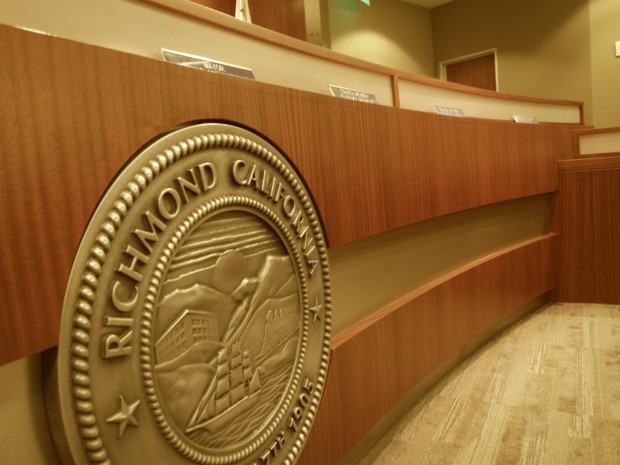
Richmond City Council. (Photo by Tawanda Kanhema)
By Larry ZhouPosted March 6, 2015 11:34 am
A divided Richmond City Council has rejected a zoning amendment that would allow a digital advertising billboard on the I-80 corridor for the troubled Hilltop business district. Leaders in the Hilltop district have urged the city to allow a digital billboard to promote the businesses there since 2007, but the city’s sign ordinance currently doesn’t allow such signs.
Last March, the city council directed staff from the Planning & Building Services Department to create a zoning amendment that would permit and regulate digital signage, according to associate planner Kieron Slaughter. And on Tuesday night, city staff recommended the council adopt the amendment. But the planning commission recommended the council only adopt the part of the amendment that would legalize the digital signs public service entities use, not the part that would permit the advertising billboards the Hilltop business community wants.
City council passed the planning commission’s recommendation with Councilmembers Eduardo Martinez, Gayle McLaughlin, Vinay Pimple and Mayor Tom Butt voting yes, and Councilmembers Jovanka Beckles, Nat Bates and Vice Mayor Jael Myrick voting no.
Digital billboards “are nothing but blight,” Butt said. He also questioned the effectiveness of digital signs in promoting business. “In the last election, one of our local companies bought essentially every billboard in Richmond, and filled them with political ads. Not one single person in these political ads prevailed in the election,” Butt said.
“I’m convinced that the primary drive in this whole thing is a profit motive from the sign industry,” he continued.
McLaughlin said a digital sign doesn’t match her vision for the city. “I would rather see public arts sculptures with lights that draw my attention to something subliminal, or some emotional feeling, than these bright blight of advertising subliminally affecting me by saying ‘Buy me,’ or ‘Buy this or buy that,’” she said.
But Beckles, Myrick and Bates supported the revisions that would allow and regulate digital signs. Beckles said she thinks they are “modern,” but she said the most important reason of her support is that “the community wants it. They have been fighting for this.”
Both Myrick and Bates said that there are digital signs all the way from Port of Oakland to Berkeley and along the I-80 freeway to the Pacific East Mall.
Myrick said that he supports the digital signs and wants them to come with some community benefits. “I look forward to us making sure we get it right, make sure the MOU [memorandum of understanding] that we vote on is solid,” Myrick said.
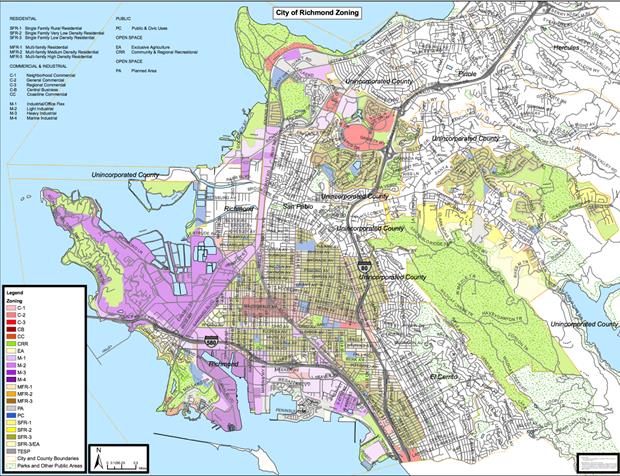
The three areas colored red are zoned as C-3 regional commercial areas according to a city zoning map. Screenshot taken March 6, 2015.
Pimple threw himself into the camp rejecting the revisions. He was concerned that the revisions would allow digital billboards in all three commercial districts in Richmond, including the Pacific East Mall area, the Macdonald Avenue area and the Hilltop Mall area. If the revisions were adopted, “The C3 zone on I-80 and Macdonald would have become open for digital advertising even though there was no demand from the community (including the business community) for such a sign,” Pimple wrote in an email after the council meeting. “The Pacific Mall sign would have been grandfathered in without a proper process.”
Pimple said in the email that he wants to “create more narrowly tailored provisions.”
Slaughter said these three areas were selected for fairness. “We want to at least make it fair,” Slaughter said, “so that our three main shopping districts were able to advertise and have signage to attract people to their businesses.”
In a letter to the planning commission, homeowners and business owners in the Hilltop District wrote that they support the amendment to permit the signs. They said in the letter that the amendment could help Hilltop Mall find a new owner, increase home values and bring more businesses and jobs to the area. Cesar Zepeda, the president of Hilltop District Neighborhood Council, said that the Hilltop community will keep pushing for a new ordinance to allow digital signs in the area.
Appendix 4 - Stopping East Bay billboard plague
May 19, 2014
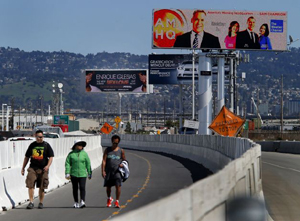
Photo by Brant Ward/San Francisco Chronicle/Polaris.
A plague of giant digital billboards threatens to blight the East Bay, but Scenic East Bay, with the support of the Sierra Club’s Northern Alameda and West Contra Costa County Groups, is working to stop them.
The three existing billboards along the approach to the Bay Bridge are already a conspicuous blight, visible from the Oakland and Berkeley hills, Emeryville, Treasure Island, and even Sausalito. They distract drivers and endanger lives.
Foster Media has proposed five additional double-sided billboards (see February 2013, page 8) near the toll entry. Three (applications number 3, 4, and 5) have been approved by Caltrans and may be constructed. Of the five, #1 and #2 near the toll entry would be particularly offensive, towering over the new bike/pedestrian path and on the edge of the planned Gateway Park. Because of public pressure from Scenic East Bay, and because Cal-trans long ago designated this a “landscaped freeway”, Foster has withdrawn its application for location #1 and has not yet submitted its application for #2. With continued public attention, Scenic East Bay is hoping to permanently protect this area from billboard construction.
The anti-billboard coalition, which includes Bike East Bay, Oakland Heritage Alliance, Citizens for Eastshore Parks, and Golden Gate Audubon, used time-tested tactics to win this partial victory: calling the press, educating the public and ourselves, making tee shirts and lawn signs, and showing up at Mayor Quan’s press conference to inaugurate the Bay Bridge. We set up numerous meetings with Oakland councilmembers and advisors, staff of state legislators, Oakland Mayor Quan, and the Caltrans department that handles outdoor advertising.
Caltrans should revoke the approvals for billboards #3 - 5. Under Caltrans regulations, such billboards are allowed only within 1,000 feet of a commercial business. The November 2013 applications cited Arthur Freyer Lighting, but this business had relocated to Berkeley the previous May, and the building is slated for demolition. Now it looks as though the East Bay Municipal Utility District sewage facility may be cited as the nearest business! Especially objectionable is billboard #3, which would rise out of a landscaped area, marring the bikeway/pedestrian path, spilling light unnecessarily, interrupting East Bay views, and distracting drivers in a complex series of intersections.
In addition, 11 more billboards may be in the pipeline for Oakland once the city enters into contracts following a Request for Proposals issued by the City Council three years ago. Despite Oakland’s long-standing regulations against new billboards, and its fighting and winning a 10-year-long lawsuit about them, elected officials are now intrigued by a potential source of revenue.
Other current fights regarding East Bay billboards include the illegally operating LED billboard at the Pacific East Mall in Richmond. Its permit limits it to publicizing on-site businesses, but it has been selling space to off-site advertisers. On May 13, the City Council voted to refer the problem to the Planning Commission.
On March 3 the Albany City Council amended its billboard ordinance to allow digital billboards in the Commercial Mixed Use Zoning District, apparently to pave the way for an enormous wall-mounted LED billboard on its proposed new public-works building.
|
|

